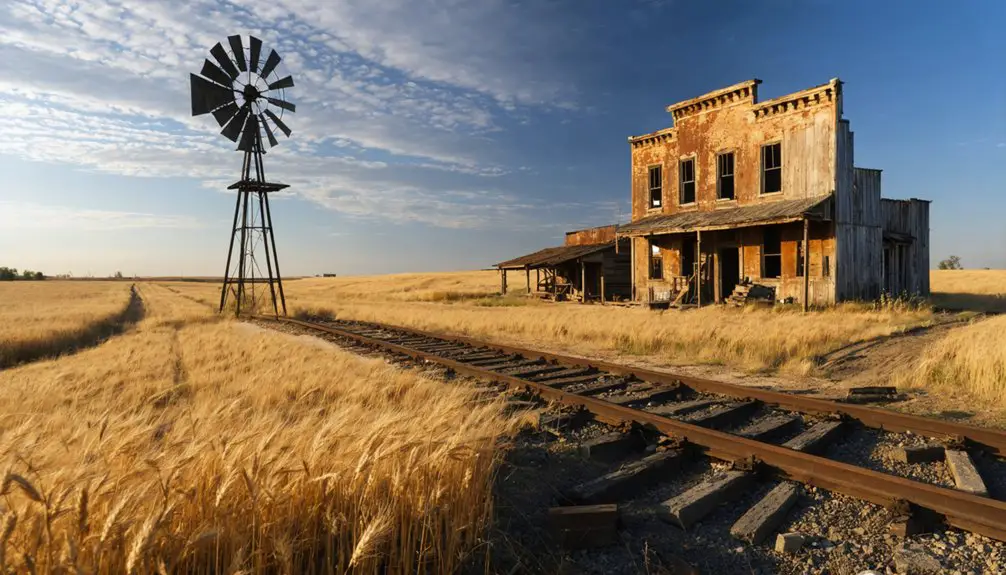You’ll find Alpha, Oklahoma’s ghost town remnants 5.5 miles east of Omega in Kingfisher County, where settlers established an agricultural community during the 1890s Land Runs. The town featured a post office (1893-1903), the progressive Alpha School District #78, and several businesses including the Ringo Hotel. When railroad routes bypassed the settlement, residents gradually abandoned Alpha for better-connected towns. Today, this 1,165-foot elevation site preserves stories of Oklahoma’s territorial ambitions.
Key Takeaways
- Alpha was established in Kingfisher County during the 1890s Land Runs but declined when railroad routes bypassed the settlement.
- The post office operated from 1893 to 1900, serving as a vital community hub before the town’s eventual abandonment.
- Alpha’s population dramatically decreased between 1898-1903, with over 80% of residents leaving for towns with better transportation access.
- The Alpha schoolhouse, founded in 1893, was preserved by relocation to the Frontier Country Historical Society in 2005.
- The ghost town site is located at coordinates 35.87028°N, 98.10056°W, approximately 5.5 miles east of Omega at 1,165 feet elevation.
Early Settlement and Establishment
While many Oklahoma Territory settlements emerged during the Land Runs of the 1890s, Alpha took root in Kingfisher County as a small agricultural community situated at 1,165 feet elevation.
Located about 5.5 miles east of Omega, early agriculture shaped the settlement’s development across the central Oklahoma plains. Just as alpha represents beginnings, this town marked a fresh start for many pioneer families.
You’ll find that Alpha’s story truly began when pioneers established their first homesteads in the early 1890s. The community gained official recognition with its post office on November 7, 1893.
Like many frontier settlements, Alpha’s early community dynamics centered around farming and local trade. Similar to many other ghost towns in Oklahoma, the settlement’s fate would be influenced by changing economic conditions and population shifts.
The town’s position at approximately 35.87028°N latitude and 98.10056°W longitude made it accessible for settlers seeking fertile land and new opportunities in the western part of Oklahoma Territory.
Post Office Operations and Community Growth
You’ll find that Alpha’s post office establishment in 1889 marked a significant milestone in the town’s development, serving as an essential community hub for both communication and commerce.
The post office’s presence helped attract businesses and settlers, including the Ringo Hotel, during Alpha’s brief period of growth. Like many other Oklahoma settlements, Alpha’s fate was heavily influenced by railroad routing decisions. Today the town stands as a barren site, with only faint traces of its past remaining visible.
Your understanding of Alpha’s decline begins with the post office’s closure in 1900, which signaled the end of the town’s promising start and its eventual shift to ghost town status.
Mail Service Timeline
The history of Alpha’s post office operations reflects the typical patterns of mail service establishment in northeastern Oklahoma during the territorial and early statehood periods.
Just as Ida E. Glen was influential in establishing Glenpool’s post office in 1908, Alpha’s post office likely emerged in the late 19th or early 20th century, serving as an essential hub for community connectivity in Craig County.
Like many small Oklahoma settlements, Alpha’s mail service played a significant role in linking isolated residents to the wider world. Similar to the post office in nearby Banzet, which operated northwest of Welch, Alpha served a vital rural community.
When Rural Free Delivery routes expanded across Oklahoma between 1900 and 1904, they transformed how mail reached remote areas.
While the exact dates of Alpha’s postal operations aren’t recorded, you can trace its likely decline through the region’s pattern of consolidation, where smaller post offices merged with larger towns’ operations as railroad routes and population centers shifted.
Community Hub Role
As a central fixture of Alpha’s development, the post office emerged as more than just a mail distribution point – it became the heart of civic life and commerce during the town’s brief existence.
You’d find townspeople gathering there daily, exchanging news and strengthening community identity through face-to-face social interactions.
The post office’s strategic location shaped Alpha’s growth pattern, with businesses clustering nearby to capitalize on the steady flow of residents.
Local merchants relied on the postal service to maintain essential commercial connections, while farmers depended on it to coordinate agricultural shipments and receive market information.
Beyond its practical functions, the facility served as a symbol of Alpha’s legitimacy, attracting settlers and fostering the shared sense of purpose that defined the town’s peak period.
The author’s 8,000-mile journey across Oklahoma revealed how vital these postal hubs were to small-town survival.
Similar to Keith Cemetery’s post office history from 1894 to 1904, Alpha’s postal operations represented a crucial period of community development.
The Alpha Schoolhouse Legacy
Serving as a cornerstone of rural education, Alpha School District #78 began its legacy in 1893 when Mrs. Dora Brown taught classes in the local Congregational Church Building.
The school broke social barriers by enrolling both white and black students during its first year, making it a pioneer in community integration during Oklahoma’s territorial period. Similar to Edmond’s historic schoolhouse, it was established by fifteen local women who saw the need for education in their community.
Breaking racial barriers before statehood, this pioneering school embraced integration when few others dared to challenge social norms.
You’ll find the schoolhouse’s influence extended well beyond education. After merging with Greenwood in 1933 and Omega in 1947, the building continued serving as a gathering place for the Alpha Extension Homemakers. Located 9 miles west of Kingfisher, the schoolhouse became a vital hub for the farming community.
In 2005, preservationists relocated the structure to the Frontier Country Historical Society, where volunteers like Dustin Staford and Daryl Poe have worked to restore its historic character.
Today, the schoolhouse stands as a symbol of rural Oklahoma’s educational heritage and early progressive values.
Decline and Abandonment Timeline
Founded in 1893 within Kingfisher County’s promising frontier, Alpha’s decline began almost immediately due to its isolation from essential railroad connections.
You’ll find that within the first five years, economic shifts drove significant population migration to nearby towns with better transportation access.
The town’s deterioration accelerated rapidly between 1898 and 1903. During this period, you’d have witnessed an exodus of over 80% of Alpha’s residents, who sought opportunities in more prosperous communities.
The closure of the post office in 1903 marked the final chapter of Alpha’s brief existence. By the early 1900s, the once-hopeful settlement had virtually disappeared, with abandoned buildings falling into disrepair.
The town’s swift shift from settlement to ghost town reflects Oklahoma’s broader pattern of boom-and-bust communities.
Geographic Significance in Kingfisher County

You’ll find Alpha’s location at 35°52′13″N 98°6′2″W positioned it strategically among early territorial settlements in Kingfisher County, established in 1890.
Alpha’s proximity to State Highway 3 and its position 5.5 miles east of Omega made it a minor waypoint for regional trade during the late 19th century.
The community’s elevation of 1,165 feet and fertile surroundings supported agricultural development, though its unincorporated status limited its growth compared to the county seat of Kingfisher.
Territorial Settlement Patterns
The territorial settlement patterns of Kingfisher County emerged through a complex change of land ownership, beginning with the Creek Nation’s forced relocation from Georgia and culminating in the dramatic land run of 1889.
After the Civil War, the Creek’s Confederate alliance led to their forced land cession, creating the “Unassigned Lands” that would shape settler motivations.
You’ll find that cultural influences from multiple groups defined the region’s development. Native American tribes like the Osage, Cheyenne, and Comanche first used these grasslands for hunting and travel.
When European-American settlers arrived in 1889, they quickly established communities like Alpha and Kingfisher, transforming the landscape into agricultural settlements.
The area’s position as a crossroads between native routes and cattle trails made it particularly valuable for early settlers seeking economic opportunities.
Location Among Trade Routes
Situated strategically within Kingfisher County’s Red Bed Plains at 1,165 feet elevation, Alpha’s location proved essential for early territorial trade networks.
You’ll find it positioned about 5.5 miles east of Omega, near crucial north-south and east-west trade routes that served Oklahoma Territory’s commerce.
The town’s placement near the Cherokee Outlet’s southern boundary made it a natural waypoint for settlers and merchants.
With its post office established in 1893, Alpha became part of the region’s postal routes, connecting it to broader economic networks.
You can trace its economic impact through its position along what’s now State Highway 3, where it served as a distribution point for agricultural goods and manufactured products moving through north-central Oklahoma’s transportation corridors.
Regional Agricultural Development
Agricultural prominence shaped Alpha’s regional identity within Kingfisher County, where farmland expanded from 400,000 acres in 1910 to over 560,750 acres by 1950.
You’ll find that while quarter-section farms initially dominated the landscape, larger operations emerged as agricultural innovation drove consolidation. By 2000, you’d see 144 farms exceeding 1,000 acres, compared to just 10 in 1930.
The region’s crop diversification centered on wheat and rye production, with the county once claiming the world’s leading wheat market title in 1895.
You’ll appreciate how five flour mills and ten grain elevators supported this agricultural empire. The county’s farming success continues today, ranking 7th in Oklahoma for grain-related sales and 11th overall for agricultural products, with crop sales reaching $31.3 million in 2017.
Preservation Efforts and Museum Relocation

Since 1993, preservation efforts for Alpha and similar Oklahoma ghost towns have gained momentum through Preservation Oklahoma’s dedicated initiatives to protect endangered historic sites.
You’ll find these preservation challenges particularly acute in remote locations like Alfalfa County, where limited community engagement and resources have accelerated site deterioration. Local historical societies and volunteers work tirelessly to maintain cemeteries and memorials, while the State Historic Preservation Office coordinates broader protection strategies.
When it comes to protecting artifacts, museum relocation has emerged as an essential preservation tool. By moving collections to more secure, accessible locations, you’re able to better preserve Alpha’s heritage while increasing public interest.
These relocations require careful planning but often serve as preservation anchors when original sites become unstable.
Role in Oklahoma’s Ghost Town Heritage
While preservation efforts keep Alpha’s memory alive, the ghost town’s broader significance lies in its role as a microcosm of Oklahoma’s rural development patterns.
You’ll find Alpha’s story echoes throughout the state’s two thousand ghost towns, each embodying the rise and fall of rural communities between the late 19th and mid-20th centuries.
As a symbol of ghost town symbolism, Alpha’s trajectory from an active community to abandonment mirrors the challenges faced by countless small Oklahoma settlements.
Its loss of essential institutions – first the post office in 1903, then the school in 1947 – reflects the deep rural nostalgia for a time when local services anchored community life.
Today, Alpha stands as a representation of how changing economic patterns and urbanization reshaped Oklahoma’s rural landscape, making it an important reference point for understanding the state’s settlement history.
Frequently Asked Questions
What Was the Peak Population of Alpha During Its Most Active Years?
All that glitters isn’t gold when it comes to peak demographics – you won’t find exact historical census data, but given the town’s brief post office tenure, your best estimate’s between 100-200 residents.
Were There Any Notable Businesses or Industries Operating in Alpha?
You won’t find detailed records of Alpha businesses or industries, but like similar Oklahoma towns, it likely had basic services supporting local agriculture – perhaps a general store and blacksmith shop.
What Natural Disasters or Significant Events Contributed to Alpha’s Decline?
While there’s no definitive record of specific natural disasters in Alpha, you’ll find that recurring tornadoes and severe weather common to Oklahoma, combined with broader economic decline, likely contributed to the town’s abandonment.
Did Any Famous Historical Figures Have Connections to Alpha, Oklahoma?
You won’t find any famous residents or historically significant figures connected to this settlement. Historical records don’t indicate any notable personalities lived in or visited the area between 1893-1947.
What Original Artifacts From Alpha Are Displayed in the Museum Today?
You’ll discover a treasure trove of Alpha’s everyday tools, farming equipment, and household items in the museum exhibits. The artifact preservation efforts focus mainly on settlers’ belongings from the early 1900s.
References
- https://en.wikipedia.org/wiki/List_of_ghost_towns_in_Oklahoma
- https://www.wikiwand.com/en/articles/List_of_ghost_towns_in_Oklahoma
- https://en.wikipedia.org/wiki/Alpha
- https://www.okhistory.org/publications/enc/entry?entry=GH002
- https://therockerbox.com/kingfisher_county_ok_ghost_towns.htm
- https://echo.snu.edu/the-ghost-towns-of-oklahoma/
- https://www.youtube.com/watch?v=ifra0DI–dY
- https://kids.kiddle.co/List_of_ghost_towns_in_Oklahoma
- http://www.ou.edu/news/articles/2024/may/ou-researcher-unveils-book-of-oklahomas-ghost-towns.html
- https://about.usps.com/who/profile/history/pdf/first-rfd-oklahoma.pdf



